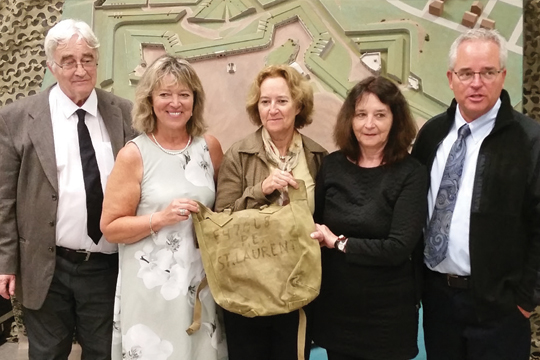
Lise Saint-Laurent Fleury, second from the left, holding the backpack surrounded by her siblings.
The Guns of August is the title of an acclaimed book about the First World War. The coincidences of August could be the title of a remarkable story of the Second World War and a family in Quebec.
It was August 2018, when Germaine Charest, the mother of Lise Saint-Laurent Fleury and her four siblings, died. Fleury, who lives in Gatineau, Que., and is retired after 35 years with the Secretary of State, Parks Canada and the Department of Canadian Heritage, recalls that that’s when unrelated events began to converge.
That same month of August happened to mark 25 years since their father, Paul-Étienne Saint-Laurent, had died, which, under federal regulations, meant the family could file a request for his military records. Lise’s sister, Francine, did just that, and they waited.
Here, the story moves to another continent and into the realm of the extraordinary. Within days of the records request, an Italian military collector named Lorenzo Campus walked into a barn in the Apennine Mountains, and saw what he recognized as an Allied-issue backpack from the Second World War hanging on a wall. The farmer let Campus take it for his collection.
Upon inspection, Campus discovered the original owner of the bag had, apparently, written his name on it; PE Saint-Laurent, service number 47068. Campus’s great-grandfather had fought with Italian Alpine troops during the war, so he decided to find Saint-Laurent’s family.
“He could have kept it for himself, but he wanted to give it to us,” Fleury says. “We were very pleased that he took all the effort to find us.”
First, he had to find the family, and because the soldier’s name was French, he began searching the war records of France and Belgium. No luck.
He realized that Francophone soldiers had come from Quebec, so after months of searching, in what had been a last-ditch effort, he called CBC in Montreal. CBC, intrigued, contacted National Archives, and “because my sister had put in the request,” Fleury says, “they had the name of my sister, the phone number.” On July 25, 2019, Francine got a call the family had never expected.
“When my sister phoned me about the backpack, I couldn’t believe it,” Fleury says. “I didn’t believe her at all — come on, 70 years after?”
Campus shipped the backpack to the family and the first night after it arrived “my sister slept with the bag,” Fleury says, smiling at the memory. “We all spent some nice moments sharing with our dad and memories with my brothers and sisters. Everybody touched it and opened it, and held it. We were so touched that my father, who was a very silent person about the war, finally, in a way, was not anonymous anymore.”
Paul-Étienne Saint-Laurent spent 48 months overseas, the last seven with the Royal 22nd Regiment, fighting German forces in Italy. When he returned to Canada, he met Charest, they moved to Ottawa and he worked for 35 years for Statistics Canada.
Though military backpacks are common artifacts, the 22nd Royal Regiment Museum at the Citadelle, Que., was interested in this one. It’s unusual to have a soldier’s name on a backpack, so the owner could be identified and a story attached to the bag.
“My father was a good writer, he had a great écriture,” Fleury says. “In the war, colleagues were asking him to write letters for them.” Saint-Laurent hadn’t told his children much about the war, but he had recalled how he would write a letter and “often a few days later, the soldier would be killed.”
“It was easy for us to decide that the best place for the bag was in the museum.”
The museum had a ceremony to install the backpack in an exhibit. Fleury and her siblings attended, though the pandemic prevented Campus from joining them. The siblings hope one day to visit Italy and meet Campus. “As a family, we want to go; he will show us where he (found) it.”

